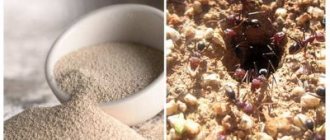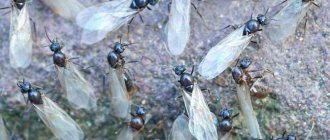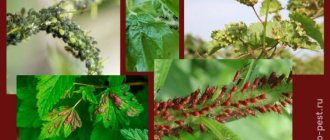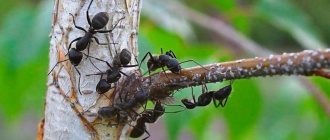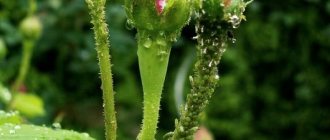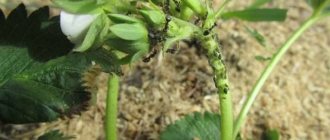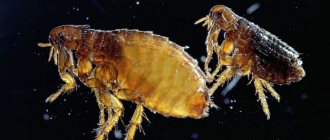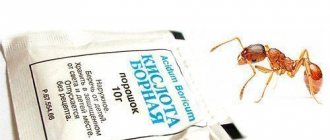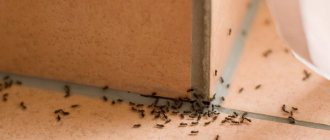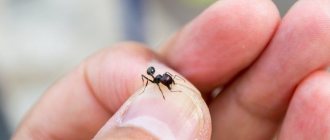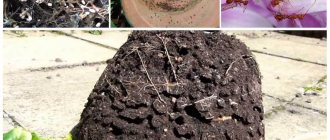Ants come to the site seriously and for a long time, build an anthill on it and form a colony with a queen at the head. The trouble is that this large family turns out to be extremely gluttonous and generally causes nothing but inconvenience.
The fight against ants in a summer cottage often takes place with varying degrees of success and does not always end in the final victory of a person. In addition, many feel sorry for the little inhabitants of the site, since since childhood they have been considered “orderlies of the forest and surrounding areas.” However, the dacha is usually ruled by garden ants, which at the same time breed aphids - the most dangerous and hardy pest. So is it necessary to get rid of ants in the country?
Forest ants are beneficial and rarely settle in gardens
Fighting ants on the site - pros and cons
Recently, the fight against ants in the countryside has become a full-scale war. You can find a huge amount of pesticides from manufacturers and garden stores that are destructive to all living things, including ants. It is believed that these insects bring invaluable benefits.
| Why are ants useful in the country? |
|
Garden ants feed on greenery and actively attract aphids to the site
However, there are still more opponents of ant families on the site, because all their advantages are offset by the indirect and direct harm that these insects cause.
| What damage do ants cause to |
|
In addition, brown , turf , red-cheeked and common garden ants , and they feed on plants and are 100% pests. Thus, you still need to get rid of ants in your dacha, and we will tell you how to do this later.
An important condition is the destruction of aphids
Ants and aphids coexist well in garden beds. Where there are aphids, ants are sure to appear. And vice versa - ants contribute to the appearance of a huge number of aphids, because they protect these aphids and protect them from predatory insects. To get a good result, you need to destroy both aphids and ants at the same time.
And for the purpose of prevention, it is important to observe the frequency and dosage of watering, treat seeds and seedlings before planting in open ground with a suitable disinfectant. Aphids love waterlogged soil and reproduce faster in it. If you water your garden in moderation, there will be no favorable conditions for its development. And it is necessary to treat seeds and seedlings with disinfectants in order to eliminate the possibility of aphid eggs being introduced into the soil.
How to choose an ant repellent
The vast majority of ant preparations contain two substances: diazinon and chlorpyrifos.
Diazinon literally “hits the heart” of insects. It blocks the production of an enzyme responsible for the functioning of the nervous system of ants. They begin to have convulsions, leading to paralysis and death. In addition, it is actively absorbed by the root system of plants and protects them from pests for 2-3 weeks.
Chlorpyrifos enters the body of insects through the respiratory system and paralyzes the nervous system. The chemical is retained in the soil for 110-120 days, and it remains effective against pests for about 1-2 months.
Below we provide a brief table of the main drugs used to kill garden ants.
| Name | Active substance | Release form | Hazard Class | Consumption rate | Time to achieve effect |
| Absolute | Chlorpyrifos | Gel, plastic containers | Class IV (low-hazard drugs) | 125 ml per 30 sq.m or 2-3 containers per 10 sq.m | 10-14 days |
| Anti-ant | Borax | Powder in blisters and bags | IV | 1 container per 1-2 sq.m. | 5-6 days |
| Bros | Chlorpyrifos | Powder | IV | 10 g per 1 sq.m. | 1 day |
| Great warrior | Diazinon, chlorpyrifos | Gel | IV | 30 mg per 1 sq.m – drops onto pieces of cardboard and place next to the anthill | 1-1.5 days |
| Grom-2 | Diazinon | Granules | Class III (moderately hazardous to humans and animals) | 1-3 g per anthill | 2-4 days |
| Delicia | Chlorpyrifos | Powder | IV | 10 g per 1 sq.m. | 10-14 days |
| Medvetox | Diazinon | Granules | III class | 20 g per 10 sq.m. | 3-5 days |
| Ant-eater | Diazinon | Emulsion concentrate | III class | 1 ml/10 l of water per 5 sq.m. | 1-2 days |
| Ant | Diazinon | Granules | III class | 20 g per 10 sq.m. | 3-5 days |
| Muratox | Diazinon | Emulsion concentrate | III class | 1 ml/10 l of water per 5 sq.m. | 3 days |
| Muratsid | Diazinon | Water emulsion | III class | 1 ml/10 l of water per 5 sq.m. | 1 day |
When treating an area against ants, it is better to use eye and respiratory protection.
Chemicals
There are many products available to control insects. The composition should contain diazinon compounds. This element immobilizes and affects the nervous system. After a couple of days, the larvae and adult ants die completely. The consumption of the product is minimal, but it is not recommended to get carried away with the drugs, as it causes serious damage and harm to the plants that will be planted in this area.
Insecticidal gels
Insecticidal gels are effective and easy-to-use remedies for annoying red ants, which can poison the nest and queen without knowing their location. The peculiarity of the action is that insects treat them as a delicacy and carry drops of gel into the anthill in working groups. Scientists selected the dosage of the poison specifically so that after eating, the ant would not die instantly, but would have time to take the poison to the nest. Breeding males and females in this way depends on the area and ranges from 2-7 weeks.
A neat droplet-shaped preparation is applied to the location of the home or onto a cardboard, which is placed next to the anthill.
Of all the products, Globol, Grom-2 is the most effective: one drop of the drug kills up to 600 individuals.
FAS and Raptor gels are popular in the fight against brown and red specimens, but also work with other species.
Initially, the bulk of the working classes die, and then the remaining pests are removed with gel.
Sturm paste is also an effective insecticide. It is important to choose the right product for your dacha.
Sticky traps
Summer residents are familiar with chains of ants climbing the trunks, branches of trees and shrubs. Insects hunt for aphid milk. For this purpose, in the spring they bring aphids to plants and receive nutrition from them. Gardeners protect the future harvest and come up with sticky belts. Instead of destroying the colony, you can limit access to the tree.
There are belts:
- funnel-shaped;
- with adhesive, sticky tape;
- with a trap.
An adhesive belt can be found in a specialty store, or you can make it yourself.
First, all cracks in the tree trunk are covered tightly with a consistency: garden pitch, plasticine, clay.
When purchasing adhesive tape for catching flies in a store, pay attention to ready-made gels based on glue. Their disadvantage is that they dry quickly. The tape is wound in a wide layer around the trunk, making further movement difficult.
The disadvantage of adhesive tape is that due to its non-elastic shape, the trunk does not increase in diameter. This is typical for fast-growing apple tree seedlings.
An independent hunting belt is made on the basis of grease, rosin glue, and Vaseline. Ants that get on the sticky mass die. For the material that is attached to the trunk, take cling film, any dense fabric, non-woven material or paper.
How to remove ants from a site
If you are not a supporter of chemical means of fighting ants, you can try other, more humane methods that allow you to drive ants out of the area without destroying their strong “family”. In particular, try the following methods:
- ants react acutely to various odors. Therefore, you can regularly place the following aromatic carriers around their shelter (though you yourself must be tolerant of them): anise leaves , smoked herring heads , sawdust mixed with grated garlic . Or simply pour kerosene over (but under no circumstances set it on fire!);
- If you have wormwood and parsley , you should not be afraid of ants, because they also prefer to avoid these plants. garlic among strawberry plantings ;
- you can also use vegetable oil , tobacco ash , crushed tomato and parsley , turpentine and charcoal ;
- ants avoid trees whose base is treated with hemp oil ;
- The hunting belt protects not only from various caterpillars and small insects, but also from ants. An improved barrier is a strip of foil with foam rubber placed under it ;
- Ants are poor swimmers, so trees can be protected by building clay ditches filled with water . The width and depth of the ditches may not exceed 3-5 cm, but in this case the ants will not be able to climb the tree;
- bricks , pieces of iron or stones near the nest passages and water them with an infusion of manure or any herbs (except those that repel ants). After 2-4 days, pick up these objects and pour boiling water over , simultaneously pouring hot water into the passages;
- take some yeast (a handful should be no larger than a hazelnut) and pour it with a sweet mixture of sugar , water and honey to make a paste. Distribute the mixture into matchboxes and place them around the ant nests, covering them with something. After some time, the ants will begin to avoid these places.
Ants are afraid of water and cannot overcome even streams 2 cm wide
How to deal with ants in the garden
Ants are most annoying while they are in the garden. If you want to know how to kill ants, use a few proven methods:
- to scare away ants, place a rag soaked in kerosene . calendula next to currant and gooseberry plantations - it attracts ladybugs, which actively eat aphids;
- tie the tree trunk with cotton wool or wool soaked in a carbolic solution . Also create a palm-wide soot and linseed oil
- Attach bottles of sugar water and lubricate their necks with syrup or anise oil ;
- if the ants have settled at the roots of the tree, use ordinary or bleach . Sprinkle quicklime on the ant heaps and pour water over them. A 20% solution of carbolic acid will also put insects to flight;
- Indirect attacks on ants should be done when fighting aphids. of the branches into a bowl of soap-salt or soap-ash solution and rinse there. Such a “shower” corrodes the skin of the aphid and it becomes unviable.
To prevent ants from running through trees, use hunting belts soaked in kerosene
Description of the insect
Ants are insects belonging to the family Formicidae. They can be found almost all over the world, some are protected, for example, the meadow ant (Formica pratensis) is listed in the Red Book, found in forests, and is a beneficial insect. Other species can cause real damage to our gardens. The following species are found in the immediate environment of humans:
- black garden ant (Lasius niger);
- yellow earthen (garden) (Lasius flavus);
- turf (Tetramorium caespitum);
- red or red myrmica (Myrmica rubra).
How to get rid of ants in the garden
Various methods are also used to protect garden crops from ants, and the most effective of them look like this:
- sprinkle the anthill with salt , and also scatter it along the “paths” and places of greatest concentration of insects. Add a few elderberry and wild mint to make life miserable for ants;
- add 400 g of laundry soap and 2 tbsp carbolic acid , as well as 10 tbsp. kerosene _ Thoroughly dissolve the soap and mix the composition. Water the anthill, tunnels, and also the bases of the trees along which they crawl with the resulting mixture. After 2-3 such treatments, the ants will prefer to move to another place;
- mix dried and crushed oregano with sulfur in a 1:2 ratio, dig up the ground in the place where the ants settled and fill in the prepared mixture. stove soot near the ant colony ;
- if the ants have just begun to form a colony, they can be caught with a simple bait - to do this, soak a sponge in a sugar solution and when the ants run onto it, immediately dip it in boiling water . Do this several times until the insect population is minimal;
- One of the relatively “humane” methods is the forced eviction of ants . At dusk, when all the insects have returned “home,” take a shovel and dig out the entire anthill in two or three times. Quickly transfer it, along with its inhabitants, into a bucket and take it outside the site, preferably into the forest. Pour boiling water over the hole;
- Traditionally, in open areas, ants are repelled by the smell of garlic cloves , tomato tops or parsley leaves , ground cinnamon and other pungent aromas.
The easiest way to lure ants is in fragrant and sweet traps.
Guest information
In the overwhelming majority, when people talk about ants in the garden, they mean one species – the black garden ant. This social insect is extremely widespread: its range stretches throughout Eurasia from Portugal and England to Central Siberia and northeast China.
Black garden ant
The ant itself is an insect, 3-4 mm long. Individuals capable of producing offspring are somewhat larger - up to 6 mm, and the uterus can be up to 8 mm in length. They are usually painted black, but this depends on the color of the soil in which this or that family lives. It can be brown or gray. The body is covered with a large number of hairs.
Within its range, this species can exist in almost any environment: from deserts and forests to residential apartments and offices. The secret of such adaptability of the black garden ant is its fertility, the lifespan of the ant family and the peculiarities of its formation.
A colony can number up to a million individuals. Its place of residence, an anthill, is a complex system of branched passages in the soil, penetrating up to 1 m deep. In rare cases, insects settle in hollows or rotten wood, as well as in moist soil and under stones.
The spread of garden ants is enormous. This is due to the fact that to create a new family, one fertilized female is enough, who independently creates her own anthill and no one helps her.
Flying female ant
After swarming, which occurs in July-August, females scatter over vast distances. And if everything goes well, in 2-3 months, in the place that the new “queen” has chosen for herself, a colony of at least 10 thousand inhabitants will appear, and by the end of the year there will already be more than 100 thousand.
The lifespan of the queen ant of the black garden ant can be 28 years, which is not only a record among its relatives in the family, but also among insects in general.
Black garden ant queen
Having such “strategic” means of control, ants can pose a serious problem not only for amateur, but also for professional agriculture.
Ants in the country - how to get rid of them in the house
Sometimes ants move into the house and begin to destroy food supplies in the home. To combat them, you can use the following methods:
- place baits consisting of 50 ml of water , 5-6 g of borax (tetraboric acid salt) and 50 g of sugar ;
- Those with a sweet tooth love jam – especially raspberry, cherry and strawberry. Add 20 g of fresh yeast and 5 g of boric acid to 500 g of jam . The ants will happily pounce on the delicacy, but it will most likely be their last - most of the individuals will die within 2 days;
- Since chemicals cannot be used in the apartment, you need to use products that are safe for humans, but unpleasant for insects. For example, such as sunflower oil , elderberry , tomatoes , wild mint , cloves , wormwood and garlic ;
- take a piece of old yellowed lard (100-200 g) and fry it on all sides. Leave the lard on a plate near the ant passages. Believe me, rarely is any product capable of repelling small pests so strongly;
- Boric acid against ants has been proving its effectiveness for several years now. It paralyzes the nervous system of insects and they soon die. of sugar in boric acid and leave them in this form in an open place. Or you can use 2-3 tsp. dry minced meat and soak them with 1 tsp. boric acid.
Sugar soaked in boric acid is the best remedy for ants
Safety precautions
When using all types of drugs or folk remedies, be sure to remember the safety rules:
- When carrying out processing, it is necessary to use protective gloves and, if necessary, a respirator.
- During work, you must not consume food or drinks.
- Baits should be placed in places protected from children and pets.
- When preparing solutions, do not use containers used for food purposes.
- All spraying and treatments are carried out only in dry, calm weather.
- Upon completion of work, hands must be thoroughly washed, clothes and shoes washed.
- You should always carefully read the labels and manufacturer's recommendations, observe the specified waiting period, during which you should refrain from contact with the treated surface. After using insecticides, it is necessary to strictly observe the deadlines for manual work.
Compliance with the rules listed above will avoid poisoning and other unwanted side effects.
Attention! Any chemicals used in the garden can affect our immediate environment. Their use must be taken into account, especially when children and animals (dogs, cats) live in the house. Chemicals also affect crops (vegetables, fruits) and other insects (for example, beneficial pollinators - bees).
Ants are one of the most common garden pests. Without timely treatment, their colonies quickly spread throughout the area, causing serious damage to various crops.
